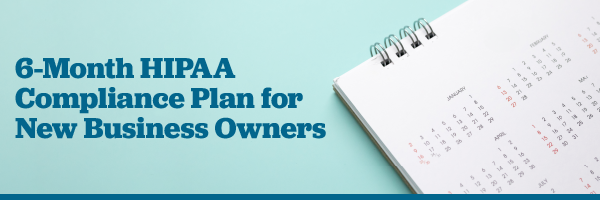
Starting a new healthcare business is exciting, but it can also be overwhelming, especially when it comes to HIPAA compliance. As a small healthcare business owner, you’re not just responsible for providing quality care – you’re also tasked with protecting your patients’ sensitive information. Don’t worry, though! We’ve got your back. This 6-month HIPAA compliance plan will guide you through the process, step by step.
Month 1: Appoint a Privacy and Security Officer
Your journey to HIPAA compliance begins with appointing a Privacy and Security Officer. This person will be your HIPAA champion, overseeing all compliance efforts. They’ll be responsible for:
Developing privacy and security policies
Conducting risk assessments
Ensuring ongoing compliance
Implementing policies through employee acknowledgment
Establishing a code of conduct for your organization
Choosing the right person for this role is crucial. Look for someone who’s detail-oriented, understands healthcare operations, and can effectively communicate with all levels of your organization.
Month 2: Conduct a Comprehensive Risk Assessment
Now it’s time to take a good, hard look at your operations. Perform a thorough risk analysis to identify any vulnerabilities in your systems and processes that handle protected health information (PHI). This assessment should cover:
Administrative safeguards
Physical safeguards
Technical safeguards
Use the results of this assessment to prioritize areas that need immediate attention. Remember, knowing your risks is the first step to addressing them effectively.
Month 3: Develop and Implement HIPAA-Compliant Policies and Procedures
With your risk assessment complete, it’s time to create or update policies and procedures that address HIPAA requirements. These should include:
Privacy practices
Security measures
Breach notification protocols
Employee sanctions for non-compliance
Ensure these policies are well-documented and easily accessible to all staff. Be sure to review them at least annually! Think of this as building the foundation of your HIPAA fortress – strong policies will protect you from many potential threats.
Month 4: Implement Technical Safeguards and Security Measures
This month is all about enhancing your IT infrastructure to meet HIPAA standards. Consider implementing:
Encryption for data at rest and in transit
Access controls
Audit logs with regular reviews (we recommend monthly)
Secure backup systems
Look for technologies specifically designed for PHI handling and protection. Remember, in today’s digital age, robust technical safeguards are essential for HIPAA compliance.
Month 5: Conduct Comprehensive Staff Training
Your staff is your first line of defense in maintaining HIPAA compliance. Develop and deliver HIPAA compliance training to all employees. Cover topics such as:
Patient privacy rights
Proper handling of PHI
Security best practices
Breach reporting procedures
Password best practices
Don’t forget to document all training sessions and attendees. An educated team is an empowered team when it comes to protecting patient information.
Month 6: Establish Ongoing Compliance Monitoring and Maintenance
Congratulations! You’ve laid a solid foundation for HIPAA compliance. But remember, this is an ongoing process. In this final month, set up regular internal audits and monitoring processes to ensure continued compliance. This includes:
Periodic risk assessments
Policy reviews
Staff refresher training
Develop a plan for staying updated on HIPAA regulation changes and industry best practices. Compliance is not a one-time achievement, but a continuous commitment to protecting your patients’ privacy.
By following this 6-month plan, you’ll establish a solid foundation for HIPAA compliance. Remember that maintaining compliance is an ongoing process that requires continuous effort and vigilance. Regularly review and update your policies, conduct training, and stay informed about any changes in HIPAA regulations to ensure long-term compliance. You got this!

Leave a Reply